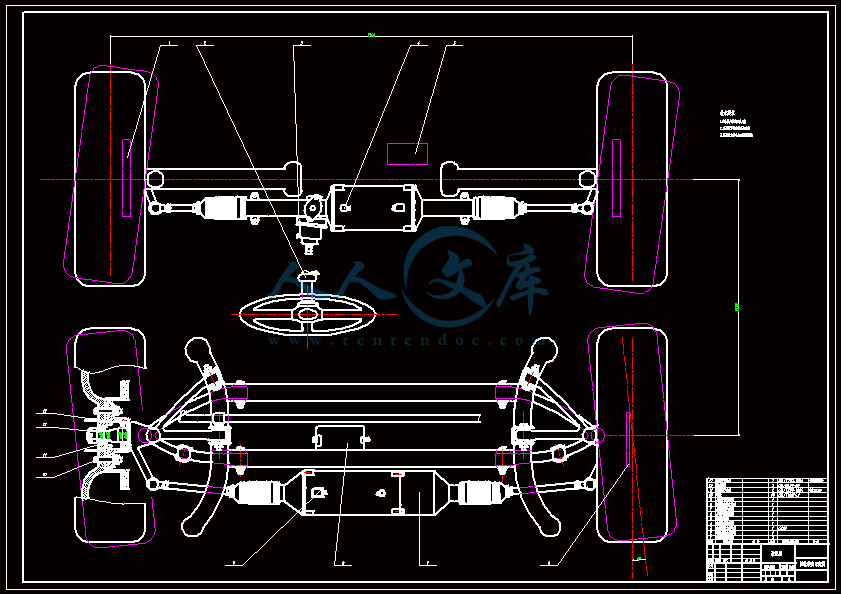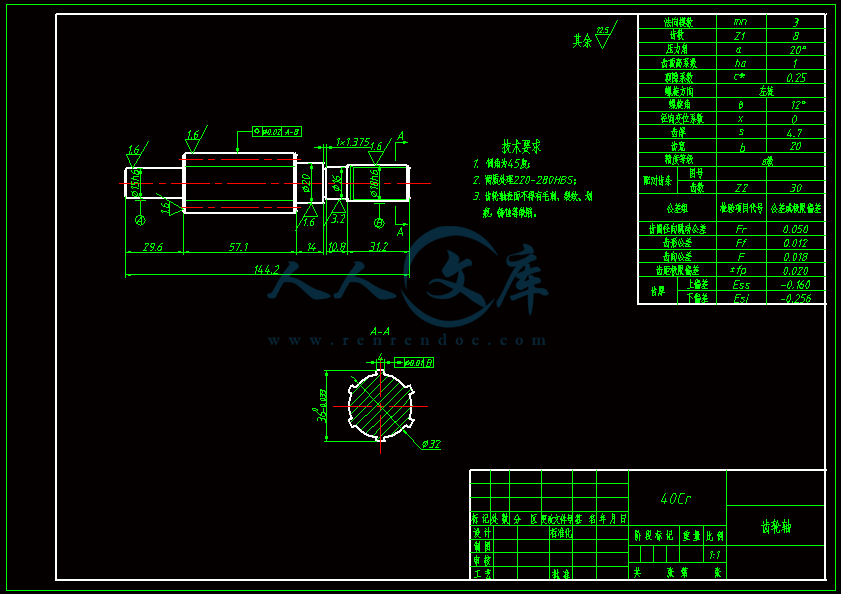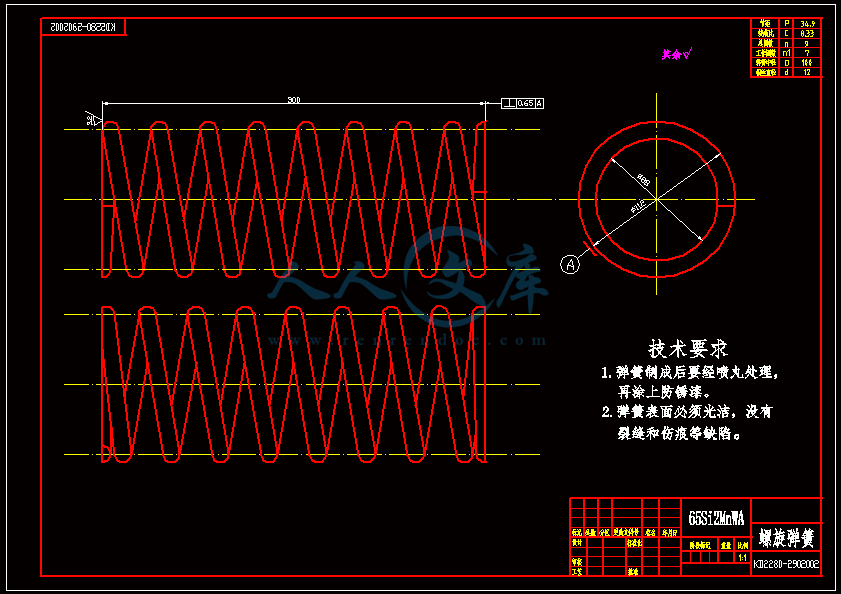汽车四轮转向传动系统设计(全套含CAD图纸)
收藏
资源目录

压缩包内文档预览:(预览前20页/共49页)
编号:10182770
类型:共享资源
大小:3.26MB
格式:ZIP
上传时间:2018-06-10
上传人:机****料
认证信息
个人认证
高**(实名认证)
河南
IP属地:河南
50
积分
- 关 键 词:
-
汽车
轮转
传动系统
设计
全套
cad
图纸
- 资源描述:
-












- 内容简介:
-
下载后文件包含有 CAD 图纸和说明书,咨询 Q 197216396 或 11970985I摘要本文主要研究了四轮转向传动系统的基本结构和工作原理,并对四轮转向传动路线进行了简要分析。以此为理论基础,以某汽车的相关参数设计了四轮转向转向器。包括前轮转向器的设计计算,后轮转向执行器的设计,齿条等强度的计算。四轮转向传动系主要是通过车速传感器、前轮转角传感器、前轮转速传感器、方向盘转角传感器、后轮转角传感器、后轮转速传感器,发送信号到四轮转向控制器内,信号经过处理,得出后轮所需的转角大小及方向,控制执行器完成转向。此系统可以改善车辆低速的转向灵活性和高速时的操纵稳定性,使汽车在转向时响应快,转向能力强,直线行驶稳定。前轮转向器是四轮转向的基础部件,是电机助力的齿轮齿条转向器。后轮执行器是驱动后轮转向的主要部件。通过对前轮转向器和后轮执行器的设计,为四轮转向技术整体设计提供了基础。关键词 四轮转向,齿轮齿条电动助力转向器,后轮转向执行器下载后文件包含有 CAD 图纸和说明书,咨询 Q 197216396 或 11970985IIAbstractThis paper mainly studies is the four-wheel steering transmission system the basic structure and working principle, and the four-wheel steering transmission routes are briefly analyzed. This theory, with a car related parameters of the four-wheel steering transmission system was designed. Including front wheel steering gear design calculation, rear wheel actuator design strength calculation, rack .Four-wheel steering transmission system is primarily through speed sensor, front wheel Angle sensor, front wheel speed sensor, steering wheel Angle sensor, rear Angle sensor, rear Lord Angle sensor, rear vice, rotational speed sensor sends a signal to the four-wheel steering controller inside, signal through processing, draw the rear required corner size and direction, control actuator finish turning. This system can improve vehicle speed steering flexibility and high speed control stability of, make cars in steering response quickly, steering capability is strong, run straight stability. Front wheel steering gear is the basic components, four-wheel steering motor hydraulically rack-and pinion steering gear Rear actuators are drive rear wheel steering the major components. Through the front wheel steering gear and rear actuator is designed for four-wheel steering technology integral design provides the basis.Key words Four-wheel steering gear rack of electric power steering gear, rear wheel actuators下载后文件包含有 CAD 图纸和说明书,咨询 Q 197216396 或 11970985III目录摘要 .IAbstract.II目录 .III第一章 绪论 .1 第二章 设计方案选择 .72.1 各传感器位置确定 .7 2.2 转向机构的设计要求 .8 2.3 转向梯形设计 .9 2.4 本章小结 .10 第三章 齿轮齿条电动助力转向器设计计算 .11 3.1 转向器的效率 .11 3.2 转向器正效率 + .11 3.3 转向器逆效率 - .12 3.4 传动比的变化特性 .13 3.4.1 力传动比与角传动比的关系 .14 3.5 参数选择 .163.5.1 转向轮侧偏角计算 .17 3.6 转向系载荷确定 .18 3.7 转向器的主要元件设计 .19 3.7.1 选择齿轮齿条材料 .19 3.7.2 齿轮齿条基本参数 .21 3.7.3 转向横拉杆及其端部 .22 3.7.4 齿条调整 .23 3.8 齿轮齿条转向器转向横拉杆的运动分析 .24 3.9 齿轮齿条传动受力分析 .25 3.10 弹簧的设计计算 .29 3.11 齿轮轴轴承的校核 .32 下载后文件包含有 CAD 图纸和说明书,咨询 Q 197216396 或 11970985IV3.12 电机选择 .33 3.12.1 助力转矩的计算 .33 3.12.2 电动机参数的选择和计算 .34 3.13 本章小结 .34 第四章 后轮转向执行器设计计算 .35 4.1 执行器结构设计 .35 4.2 齿条设计计算 .35 4.3 回位弹簧的设计计算 .35 4.4 电机选择 .37 4.4.1 助力转矩的计算 .37 4.4.2 电动机参数的选择和计算 .37 4.5 本章小结 .37 结论 .39 致谢 .40 参考文献 .41 附录 .42 下载后文件包含有 CAD 图纸和说明书,咨询 Q 197216396 或 11970985V下载后文件包含有 CAD 图纸和说明书,咨询 Q 197216396 或 11970985VI下载后文件包含有 CAD 图纸和说明书,咨询 Q 197216396 或 11970985VII下载后文件包含有 CAD 图纸和说明书,咨询 Q 197216396 或 11970985VIII下载后文件包含有 CAD 图纸和说明书,咨询 Q 197216396 或 11970985- 1 -第一章 绪论四轮转向(Four Wheel Steer)控制技术就是在汽车行驶转向时通过引入一定的后轮转向来增强汽车在高速行驶或在侧向风力作用时的操纵稳定性、行驶安全性及改善低速时汽车的机动灵活性。我们知道普通汽车的转向是靠驾驶员转动方向盘,从而带动前轮的转动来实现的,前轮为转向轮。前轮转动后,车身方向跟着改变,无转向的后轮与车身的行进方向产生差距,产生偏离角,从而发生弯力,产生转向。由此可见,传统的前轮转向汽车有低速时转向响应慢,回转半径大,转向不灵活;高速时方向稳定性差等缺点。经过二十余年的研究,4WS 技术已趋于成熟,日本的日产公司、马自达公司、丰田公司,美国的福特公司、通用公司的汽车产品上都有装用 4WS 系统。我国开展汽车四轮转向技术研究相对较晚,80 年代末和 90 年代初开始有文章探讨 4WS 问题,90 年代末,上海交通大学、浙江大学开始进行 4WS 控制方法的研究。近年来,由于电子控制技术的快速发展,以及国内愈趋紧张的交通状况,四轮转向控制技术越来越被汽车厂商及各高校重视,在 2003 年和 2005 年海峡连杆机构学术研讨会上台北科技大学代表分享了后轮转向机构设计以及四轮转向控制防侧滑等理论成果。通过对目前四轮转向技术的研究,我参照已有车型的参数设计了四轮转向的前轮转向器和后轮转向执行器,为国内四轮转向技术的发展提供基础。【技术说明】后轮转向与前轮主要有两个不同的相位转角,当车速较低时后轮与前轮转向相反称为逆向位转角如图(1-1) ,当车速较高时后轮与前轮转向相同称为同相位转角如图(1-2) 。 下载后文件包含有 CAD 图纸和说明书,咨询 Q 197216396 或 11970985- 2 -(a)2WS (b)4WS图(1-1) 4WS 低速时逆向位转向(a)2WS (b)4WS图(1-2)4WS 高速时同向位转向四轮转向系统的控制目标主要包括:1.减小侧向加速度响应和横摆角速度响应的滞后;2.减小汽车的侧偏角;3.增强汽车的行进稳定性;4.改善低速范围汽车的操纵性;1The Mazda Speed Sensing Computerised 4-Wheel Steering System. Three and a half decades ago, two young Mazda designers arrived at a far-sighted and well-calculated conclusion that was quite revolutionary for the time. In their technical presentation at the October 26, 1962 Japanese Automotive Engineers Society Technical Conference, Dr Tadashi Okada and engineer Toshiaki summarised their arduous research concerning vehicle dynamics as follows. 1. The basic difference in the characteristics of oversteer and understeer lies in the magnitude of time delay and response. 2. a vehicle that is stable under high speed must possess understeer characteristics 3. the rear wheel tyre reflects heavily on the stability 4. a major improvement on control and stability may be anticipated by means of the automatic rear wheel steering system. The conclusions and formulations presented by these two engineers established the foundation for Mazdas present-day reputed suspension technology. Over years of dedicated research and development expertise, their original discoveries and theories have contributed to some of the most significant achievements within the recent history of automotive chassis engineering, incorporated by Mazda within its series production products. These developments include the twin trapezoidal link rear suspension, first employed in the original front-wheel drive Mazda 323 (1980) and the Mazda 626 (1982), and then perfected within the updated Mazda 626; the award winning Dynamic Tracking Suspension System of the second generation Mazda RX-7 (1985); and the elaborate E-link rear suspension of the new Mazda 929 (1987). While various external forces and loads are exerted to the rear wheels of a vehicle as it combats the elements of the law of motion as defined by Sir Isaac Newton, these new suspension systems convert those forces into “4WS effects“ which positively aid in vehicle stability and agility. The Mazda designers and engineers ultimate goal was still a positive measure to generate forces for positive controls; a Four-Wheel Steering system. 2In 1983, Mazda astonished the automotive world with the introduction of an engineering concept car, the MX-02, exhibited at the Tokyo Motor Show. This four-door Sedan, with generous passenger accommodation on an unusually long wheelbase, incorporated among its numerous advanced features a true 4WS system that aided high-speed stability as well as its low-speed manoeuvring. The degree of rear wheel steering was determined by the measurement of both front wheel steering angle and vehicle speed, by means of a central computer unit. The MX-02 was followed by another exciting concept car; the MX-03, first exhibited at the Frankfurt Motor Show in September 1985. This sleek four seat futuristic coupe of the 1990s combined a refined electronically-controlled 4WS system with a continually varying torque-split, four-wheel drive system and a powerful three-rotary engine. Mazda Electronically -Controlled Four-Wheel Steering System: A Beneficial Technology Mazdas electronically-controlled, vehicle-speed-sensing Four-Wheel Steering System (4WS) steers the rear wheels in a direction and to a degree most suited to a corresponding vehicle speed range. The system is mechanically and hydraulically actuated, producing greatly enhanced stability, and within certain parameters, agility. The driver of a Mazda 4WS-equipped car derives five strategic benefits, over and above the conventional vehicle chassis. Superior cornering stability 1.Improved steering responsiveness and precision 2.High-speed straightline stability 3.Notable improvement in rapid lane-changing manoeuvres 4.Smaller turning radius and tight-space manoeuvrability at low vehicle speed range The most outstanding advantage of the Mazda 4WS is that it contributes to a notable reduction in driver fatigue over high-speed and extended travelling. This is achieved by optimally: 31.reducing the response delay to steering input and action and 2.eliminating the vehicles excessive reaction to steering input In essence, by providing the optimum solution to the phenomena researched by the two young Mazda engineers in the early sixties - by the method advocated by them - the 4WS system has emerged as a fully beneficial technology. Strategic Construction The Mazda 4WS consists of a rack-and-pinion front steering system that is hydraulically assisted by a twin-tandem pump main power source, with an overall steering ratio of 14.2:1. The rear wheel steering mechanism is also hydraulically assisted by the main pump and electronically controlled - according to the front steering angle and vehicle speed. The rear steering shaft extends from the rack bar of the front steering gear assembly to the rear steering-phase control unit. The rear steering system is comprised of the input end of the rear steering shaft, vehicle speed sensors, a steering-phase control unit (determining direction and degree), a power cylinder and an output rod. A centering lock spring is incorporated, which locks the rear system in a neutral (straightforward) position in the event of hydraulic failure. Additionally, a solenoid valve that disengages hydraulic assist (thereby activating the centering lock spring) in case of an electrical failure is included. The 4WS system varies the phase and ratio of the rear-wheel steering to the front wheels, according to the vehicle speed. It steers the rear wheels toward the opposite phase (direction) of the front wheel during speeds less than 35km/h (22mph) for a tighter turn and “neutralizes“ them (to a straightforward direction, as in a conventional two-wheel steering principle) at 35km/h (22mph). Above that speed, the system steers toward the same phase-direction as the front wheels, thereby generating an increased cornering force for stability. The maximun steering angle of the rear wheels extends 5 degrees to either left or right, a measurement that Mazda has determined to be optimally effective and natural to human sensitivity. 4Primary Components 1. Vehicle speed sensors Interpret speedometer shelf revolutions and send signal to the electronic computer unit. two sensors, one within the speedometer and the other at the transmission output, are used to crosscheck the other for accuracy and failsafe measures. 2. Steering phase control unit* Conveys to the power steering cylinder booster valve thedirection and stroke of rear wheel steering by the combined movement of the control yoke angle and bevel gear revolutions. 3. Electric stepper motor Performs altering of the yoke angle and bevel gear phasing 4. Rear steering shaft Transmits front wheel steering angle by turning the small bevel gear in the steering phase control unit, which rotates the main bevel gear in the assembly. 5. Control valve Feeds hydraulic pressure to the steering actuator, according to the phase and stroke required for appropriate rear wheel steering. 56. Hydraulic power cylinder Operates the output rod by hydraulic pressure and steers the rear wheels. It locks the rear wheels in a “neutral“ (straightforward) position with the centering lock spring, which is activated by a solenoid valve in case of failure to ensure a normal 2WS function for the vehicle. 7. Hydraulic pump. Provides hydraulic pressure to both the front and rear steering systems. Details of Steering Phase Control Unit The steering phase control unit alters the direction and degree of rear wheel steering. It consists of a stepper motor that controls the rear steering ratio, a control yoke, a swing arm, a main bevel gear engaged to the rear steering shaft via a small bevel gear, and a control rod connected to the control valve. It operates: a. Opposite phase (direction) steering under 35km/h (22mph) 1. Control Yoke is at an angle activated by the stepper motor 2. Front wheels are steered to the right. The small bevel gear is rotated in direction X by the rotation of the rear steering shaft. The small bevel gear, in turn, rotates the main bevel gear. 3. Rotation of the main bevel gear causes movement of the control rod toward the control valve. 4. Input rod of the control valve is pushed to the right, according to the degree of the control rods movement (determined by the disposition of the swing arm), which is 6positioned to move in an upward direction, to the right. The rear wheels are thus steered to the left, in an opposite direction to the front wheels. 5. As the angle of the control yoke is increased in direction A as vehicle speed decreases, the rear-to-front steering ratio proportionately increases and the vehicles steering lock tightens. b. Same phase (direction) over 35km/h (22mph) The operation of this phase is the reverse of the opposite phase one, because the control yoke is angled toward “positive“ in this vehicle speed range, as illustrated. The phasing of the swing arm, yoke rod and bevel gear steers the rear wheels toward the right-the same direction as the front wheels. c. Neutral phase, at 35km/h (22mph) The control yokes angle is horizontal (neutral). Thus, the input rod is not affected, even if the control rod is moved with the rotation of the bevel gear unit. As a result, the rear wheels are not steered in this mode. Power Cylinder The movement of the input rod of the control valve unit is transmitted to the power cylinders spool. The spools displacement to the sleeve causes a pressure difference between the right and left side chambers in the hydraulic power cylinder. The pressure difference overcomes the output shaft load and initiates sleeve movement. The sleeve-power rod assembly is moved in the direction of the input rod by a proportionate degree. The output rod transmits steering action to the tie rod on either end of the rear wheel steering control-mechanism unit, thereby steering the rear wheels. Fail-Safe Measures 7The system automatically counteracts possible causes of failure, both electronic and hydraulic. In either case, the centering lock spring housed in the steering system unit returns the output rods in the “neutral“ straightforward position, essentially alternating the entire steering system to a conventional 2WS principle. Specifically, if a hydraulic defect should render a reduction in pressure level (by a movement malfunction or a broken driving belt), the rear wheel steering mechanism is automatically locked in a neutral position, activating a low-level warning light. In the event of an electrical failure, such would be detected by a self-diagnostic circuit integrated within the 4WS control unit, which stimulates a solenoid valve and then neutralizes hydraulic pressure and return lines, thereby alternating the system again to that of a 2WS principle. Henceforth, the warning light referencing the 4WS system within the main instrument display is activated, indicating a system failure. 8翻译马自达公司的速度感应四轮转向系统三十五年前,两个马自达设计师提出了一个远见的、有计算认为是相当革命性的结论。他们在 1962 年 10 月 26 日日本汽车工程师学会技术会议上 Tadashi Okada 博士和 Toshiaki 工程师总结了他们关于车辆动力学的辛勤研究如下:1.基本特性差别在于过度转向与不足转向的量和时间上的延迟和响应。2.汽车在高速状态下应具备不足转向特点。3.后方的稳定很大程度上反映出车轮和轮胎。4.控制与稳定的一大进步,可预期的方式自动引导系统后车轮. 这种结论和提法被这两个工程师提出并为良好悬架技术的研制成立了基金会多年来致力于研究和开发,原有的理论有一定的作用,一些最重要的成就在近代历史上汽车底盘工程,将在马自达的系列产品的生产. 这些发展包括双斜后方的联系中断,首先采用原第一轮驱动 323K(1980)、马自达 626(1982),然后在更新完善马自达 626. 获奖的动态跟踪系统中断的第二代发票 RC7(1985); 并制定电子后方联系中断新马自达 929(1987). 而与此同时各种外部压力和负荷作用与汽车后方的车轮,因为它违背牛顿的运动学原理,这些新系统中断将这些力量纳入“4ws 效应“,积极帮助稳定车辆和机敏. 马自达的设计师和工程师们的最终目标仍是积极的方法产生积极的控制措施; 四轮转向体系。1983 年马自达将举世震惊的概念引入工程车 MX02 中,并在东京会展上亮相。这辆四门私家轿车在不寻常的长轴距上布置了宽敞的乘客空间,它汇聚许多先进的特点具有高速稳定和低速操控性能的真正意义的 4WS 系统。后方车轮的量取决于前方双轮的角度和汽车的速度,而这些是由中央计算机单元控制的。MX-02 之后另一个令人振奋的概念车;MX-03 于 1
- 温馨提示:
1: 本站所有资源如无特殊说明,都需要本地电脑安装OFFICE2007和PDF阅读器。图纸软件为CAD,CAXA,PROE,UG,SolidWorks等.压缩文件请下载最新的WinRAR软件解压。
2: 本站的文档不包含任何第三方提供的附件图纸等,如果需要附件,请联系上传者。文件的所有权益归上传用户所有。
3.本站RAR压缩包中若带图纸,网页内容里面会有图纸预览,若没有图纸预览就没有图纸。
4. 未经权益所有人同意不得将文件中的内容挪作商业或盈利用途。
5. 人人文库网仅提供信息存储空间,仅对用户上传内容的表现方式做保护处理,对用户上传分享的文档内容本身不做任何修改或编辑,并不能对任何下载内容负责。
6. 下载文件中如有侵权或不适当内容,请与我们联系,我们立即纠正。
7. 本站不保证下载资源的准确性、安全性和完整性, 同时也不承担用户因使用这些下载资源对自己和他人造成任何形式的伤害或损失。

人人文库网所有资源均是用户自行上传分享,仅供网友学习交流,未经上传用户书面授权,请勿作他用。
 川公网安备: 51019002004831号
川公网安备: 51019002004831号